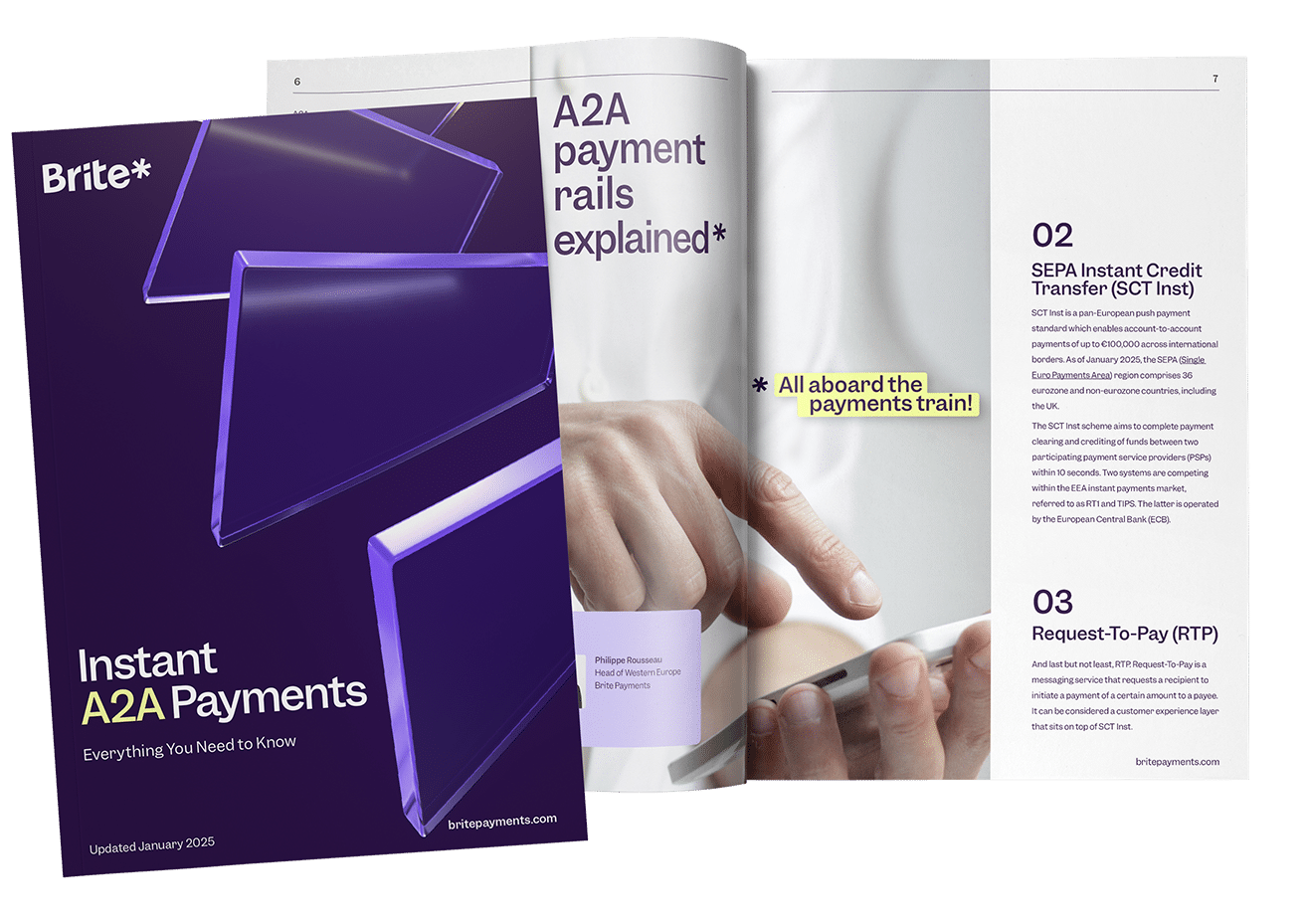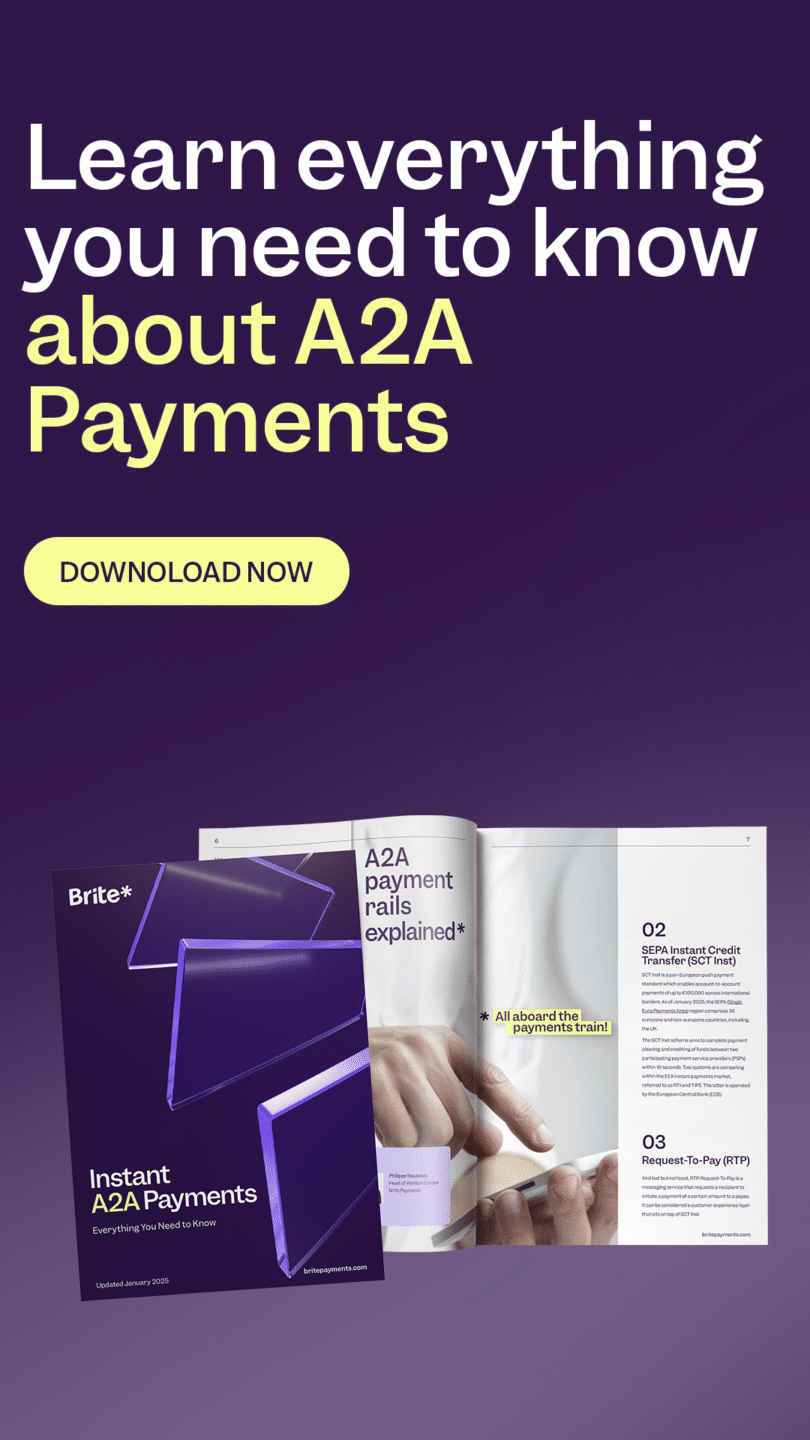Account-to-account payments explained
Everything is all Brite

What you need to know about A2A payments
Instant account-to-account payments are set for prolific growth over the next decade. Thanks to advances in open banking technology and a willingness for more capable and innovative payment methods – A2A payments are set to save consumers and merchants time, money, and headaches! Download our explainer to get a clearer understanding of:
- What account-to-account (A2A) payments are
- How A2A payments benefit consumers and Merchants
- Why not all A2A payments are the same
- Examples of A2A payment use cases across verticals
What are account-to-account payments (A2A payments)?
Account-to-account payments are direct transfers of funds from one bank account to another account bank account. They effectively bypass the need for any middlemen or payment tools like cards, reducing the number of parties involved who will take a portion of the transaction.
In the past, A2A payments have typically been associated with specific bank account transactions. Examples of A2A payments include a user making a transfer from one bank account to another, or a direct debit.
For a full, indepth explanation into all things account-to-account payments, as well as instant A2A payments download the explainer.
What are the different types of account-to-account payment systems?
There are different types of account-to-account payment systems, but the main two methods are:
- Bank-to-bank payments: These are traditional account-to-account payments that have existed for a long time. They include:
- Push payments: A payment utilised for sending one-off payments from one account to another account.
- Pull payments: A pull payment does the opposite of a push payment; it retrieves a payment from one account to another.
- Open banking-powered payments: Similar to above but on steroids! This system allows people and businesses to make fast A2A payments via application programming interfaces (APIs). It is technology that provides a secure and cost-effective alternative to using card networks. Instant A2A payments (and some versions of pay by bank) are examples of open banking-powered A2A payments.
What’s the difference between A2A payments and Pay by Bank?
The terms are often used interchangeably, but there are differences between the two. Typically, “Pay by Bank” may refer to any payment method initiated through a bank account – including an account-to-account payment. Essentially, all A2A payments are Pay by Bank payments, but not all Bay by Bank payments are A2A payments. However, the term Pay by Bank is more and more used as the consumer facing term for an A2A payment at online checkouts. You can read more about Pay by Bank and these different nuances in our latest explainer.
Indeed, not all bank payments directly transfer funds from one bank account to another. Some bank payments, such as those made through credit cards or payment processors, involve intermediaries that incur additional fees and processing time. A2A payments, on the other hand, are direct and efficient, resulting in faster settlements and lower costs.
What is the difference between A2A and P2P payments?
Firstly, as we know, A2A payments are account-to-account payments – P2P payments, on the other hand, refer to peer-to-peer payments. And there lies the vital distinction between the two: the nature of the accounts involved.
P2P payments can encompass a broader spectrum of account types, including bank accounts, credit cards, and digital wallets. One such example is PayPal, which enables users to send money from one PayPal account to another. They are commonly employed for more informal expenses like splitting a bill or paying a babysitter. P2P payments can also be made using various third-party apps.
What are instant A2A payments?
Instant account-to-account payments are open banking-powered A2A payments. Unlike traditional types of A2A payment, instant A2A payments do not require the manual transferring of funds – which is prone to user input errors – or merchant authorisations, which are time-consuming.
Additionally, non-banking entities such as third-party providers (TPPs) such as Brite can provide instant A2A payments that are user-friendly, efficient, and innovative. Open banking technologies, such as APIs, allow TPPs to access bank accounts to view or initiate customer payments quickly and securely.
How has open banking impacted account-to-account payments?
Open banking has had the effect of supercharging A2A payments.
In the past, A2A payments have struggled to compete against other payment methods, such as credit cards. This is because bank transfers require payers to log into their bank accounts and manually enter account details when they want to make a payment. Additionally, recurring payments often required authorisation and involved forms to fill in for any payment to begin. It was time-consuming, and consumers did not like it.
Yet, A2A payments save merchants money in the form of card fees, and for consumers, they are as secure and straightforward as it gets when making a payment. Traditional A2A payments work and are good, but they had to evolve to something more usable to meet today’s payment challenges. Step forward open banking and open banking-powered A2A payments via third-party providers.
The beauty of this upgraded form of A2A payment is that it has removed the struggles associated with traditional A2A payments. In particular, entering account details is now an automatic process, streamlining any (recurring) payment process.
How do open banking-powered A2A payments work?
As discussed previously, open banking uses APIs to facilitate bank transfers and for users to pay, account-to-account, the consumer’s bank to a merchant’s bank, if you will. These APIs enable the direct movement of money from a payer’s account to a merchant. They do this almost instantly using the following services:
Payment initiation service (PIS): This enables third-party providers (TPPs) to initiate payments directly from a consumer’s bank account, making online transactions efficient. PIS for the consumer means a secure and convenient way to pay online without sharing card details and enabling payments directly from their bank account.
Account information service (AIS): Additionally, TPPs can view financial and selected account information from customer bank accounts. For example, when a customer is onboarding at the same time as making payment or applying for a loan.
Effectively, open banking now enables A2A payments to be used easily at the point of purchase instead of card payments. They offer speed and ease of use minus manual data entry and intermediaries adding to the cost of making a transaction.
How long does it take for an A2A payment to arrive?
Depending on the technology used, an A2A payment is one of the fastest payment types around. However, older types of A2A payment – without the benefit of open banking and PIS – can still be delayed due to:
- Different banks and financial institutions’ different processing times.
- A recipient bank experiencing technical difficulties.
- Or a payment being flagged for review by the recipient’s bank.
- Then there is, of course, legacy batch processing, too.
Indeed, payments made via open banking-powered A2A payments, which may use proprietary networks such as Brite IPN, take seconds and are virtually instant. Plus, they do not suffer from manual input errors.
How do A2A payments compare to other payment methods like credit cards?
As mentioned, A2A payments cut out the middlemen and reduce the steps required to make a payment. This can be best seen when compared to a traditional card payment, like a credit card payment. It’s worth noting that A2A payments are considerably more sustainable than traditional payment methods (as well as some newer ones!) too.
Likewise, not all A2A payments are alike. Indeed, instant A2A payments such as those provided by Brite Payments reduce the steps needed to process and reconcile a payment, making them the ideal online payment option for both consumers and merchants. See the video below for the basics.
What are the security features of account-to-account payments?
Instant A2A payments are some of the most secure payment transactions in the world. Key security features include:
Bank-level security: A2A payments use a bank’s secure systems and benefit from the same protective measures that guard other financial dealings.
Strong customer authentication (SCA): SCA is a stipulation based on the 2018 update of the EU Payment Services Directive (PSD2). It’s also something that is gradually becoming more prevalent across other non-European markets too. SCA necessitates two-factor authentication (2FA) for certain payment types, like A2A transactions. This means consumers must provide two types of credentials, for example, a password and a one-time code sent to a phone, to validate a payment.
Limited sharing of sensitive information: Unlike payment methods like credit or debit cards, A2A payments don’t require you to divulge your card details to the merchant, thereby lowering the risk of fraud.
Complete control: With A2A payments, consumers have total command over funds. The consumer decides who to pay, how much to send, and when to send it. And when a consumer has paid with an A2A payment, there is no way of reversing or cancelling transactions.
In addition to these standard security features, some A2A payment providers may offer extra safeguards such as:
Fraud detection and prevention: A2A payment providers may employ various techniques, including machine learning and artificial intelligence, to spot and block fraudulent activities.
Data encryption: A2A payment providers might encrypt all sensitive data, which includes account numbers and transaction amounts, to protect it from unauthorised access.
Dispute resolution: If an issue is encountered with an A2A payment, a consumer can lodge a dispute with the payment provider.
Overall, A2A payments provide a highly secure method for making payments or transferring funds.
What are the barriers to the adoption of instant account-to-account payments?
There are still some barriers that still need to be overcome for the widespread adoption of instant A2A payments.
Oddly enough, the main barrier to adopting account-to-account payments is related to the dominance of existing payment systems and educating consumers about the specific benefits of the payment method.
The reality is that A2A payments are a popular payment method – but cards are still by far the most popular payment method. However, in certain countries, such as the Netherlands A2A payments are leading thanks to A2A payment methods such as iDeal.
Indeed, when making a regular bank transfer, it is unlikely consumers will actively describe themselves as making an A2A payment. Therefore, instant A2A payments are sometimes described as pay by bank in some regions to highlight the secure nature of the payment method.
What is the future of account-to-account payments in Europe?
The future of account-to-account payments in Europe is extremely promising and growing. Worldwide, A2A payments accounted for 9% of e-commerce payments and $525B in transaction value in 2022, according to the Worldplay Global Payments Report. Safety, speed, and lower cost are contributing to the uptake by both consumers and merchants alike.
According to that same Worldplay report, A2A payments now account for 18% of e-commerce payments, with a projected growth of 10% CAGR each year to 2026. However, even within Europe, the countries that are seeing, and will see, the most substantial adoption of A2A payments – in particular, instant A2A payments – are Germany, the Netherlands, the Nordics and the UK. This is due to solid adoption rates because of existing digital payments infrastructure, innovative local providers and digitally savvy consumers.

